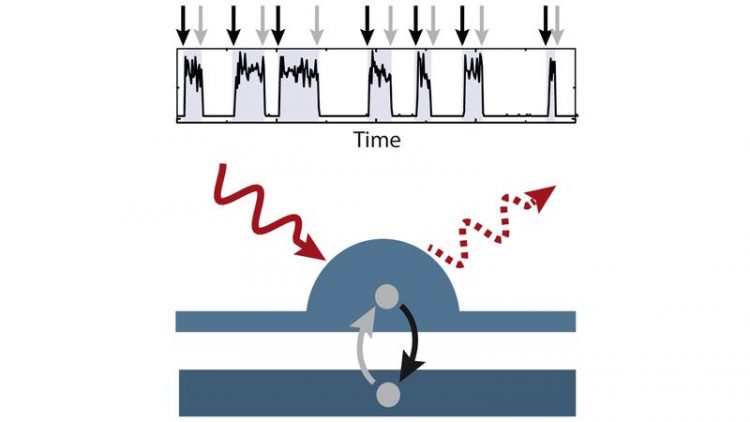Dynamics in quantum dots: Smallest measurable processes recorded individually

Illustration of the measuring method M. P. Geller, UDE
The experimental setup included a quantum dot – i.e. a solid structure of only about 10,000 atoms – next to a reservoir with electrons. About 100 times per second an electron jumps back and forth between this structure and the reservoir.
It can jump into a high or low energy state into the quantum dot and change inside from top to bottom. For the first time, the researchers were able to observe this change through these tiny jumps.
“This measurement of every single quantum jump is the maximum information that can be extracted from a quantum system, because there aren’t any other or faster processes that can be measured”, explains Dr. Martin Paul Geller from the Collaborative Research Center 1242 Non-Equilibrium Dynamics of Condensed Matter in the Time Domain.
For the project, the team of experimental physicists collaborated with colleagues from theoretical physics in the working group of Professor Dr. Jürgen König (UDE). The theoretical physicists statistically analyzed the data and for the first time could made statements about the dynamics of the electrons in the quantum dot.
“In principle, we worked with a highly-sensitive optical and fast microscope that has still much room for improvement”, says Geller describing the measurement technology that has been refined by the researchers. Further optimization could outperform any electrical measurement in speed and spatial resolution.
Dr. Martin Paul Geller, Faculty of Physics, +49 203 37 9-2237, martin.geller@uni-due.de
Optical Detection of Single-Electron Tunneling into a Semiconductor Quantum Dot
A. Kurzmann, P. Stegmann, J. Kerski, R. Schott, A. Ludwig, A. D. Wieck, J. König, A. Lorke, and M. Geller
Phys. Rev. Lett. 122, 247403 (2019)
https://doi.org/10.1103/PhysRevLett.122.247403
Media Contact
More Information:
http://www.uni-duisburg-essen.de/All latest news from the category: Physics and Astronomy
This area deals with the fundamental laws and building blocks of nature and how they interact, the properties and the behavior of matter, and research into space and time and their structures.
innovations-report provides in-depth reports and articles on subjects such as astrophysics, laser technologies, nuclear, quantum, particle and solid-state physics, nanotechnologies, planetary research and findings (Mars, Venus) and developments related to the Hubble Telescope.
Newest articles

Sea slugs inspire highly stretchable biomedical sensor
USC Viterbi School of Engineering researcher Hangbo Zhao presents findings on highly stretchable and customizable microneedles for application in fields including neuroscience, tissue engineering, and wearable bioelectronics. The revolution in…

Twisting and binding matter waves with photons in a cavity
Precisely measuring the energy states of individual atoms has been a historical challenge for physicists due to atomic recoil. When an atom interacts with a photon, the atom “recoils” in…

Nanotubes, nanoparticles, and antibodies detect tiny amounts of fentanyl
New sensor is six orders of magnitude more sensitive than the next best thing. A research team at Pitt led by Alexander Star, a chemistry professor in the Kenneth P. Dietrich…





















